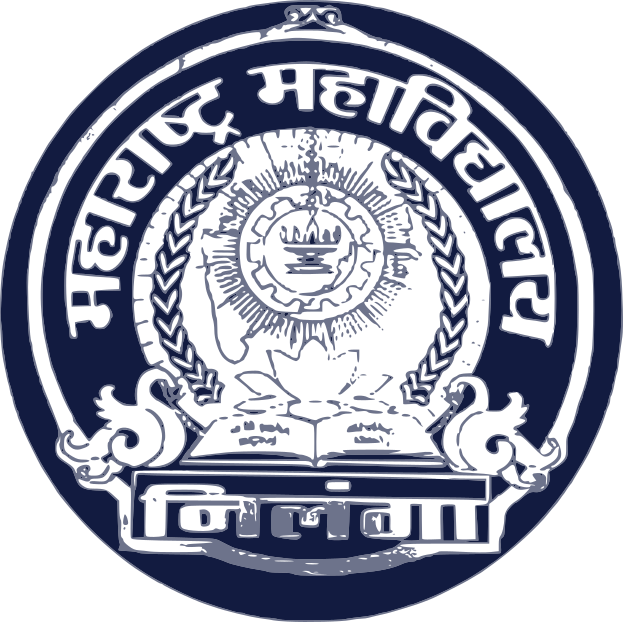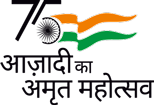Maharashtra Mahavidyalaya, Nilanga
Department of History
About the Department:
Maharashtra Mahavidyalay was started in 1970 under the Maharashtra Shikshan Samiti. The History department was started since the establishment of college. Since the establishment of department, Prof. V.B. Birajdar and Prof. M. P. Sangve were professors. Both of them worked to make the history department academically rich and prosperous. Prof. V. B. Birajdar, was the principal of the college from 1985 to 2006. He retired from the post of principal in 2006. Prof. M. P. Sangave, another professor in the Department of History, retired in 2008. Prof. Dr. Subhash Benjalwar was appointed on 6th September 2011 in the Department of History after M. P. Sangave. Currently, Dr. Subhash Ganpatrao Benjalwar is working as the head of the department and Mr. Dattatraya Pawar and Miss. Anuradha Mahajan are both working on clock hours basis.
Syllabus designed by History Board of Study, Swami Ramannand Teerth Marathwada University, Nanded is applied to affiliated colleges. By the department, co-curricular activities are conducted for the students along with the course of history subject. Activities such as history knowledge test, Poster Presentation Competition, visit to local historical places, organization of study tours to historical places etc. are conducted for the students.
Moreover, about the activities conducted by the department are: One Day National Seminar sponsored by Indian Council of Social Sciences Research, New Delhi on 01st October 2022. The seminar was organized on the theme “Maharashtra’s Contribution to the Indian Freedom Struggle” and A two-day national conference sponsored by Indian Social Science Research Council, New Delhi was concluded on 02nd and 03rd February, 2024. The conference was organized on the theme “New Research Trends in Ancient South Indian Art and Iconography – Sculptures, Caves, Stupas, Chaityagrihas, Temples and Sculptures”.
- Faculty
| Sr. NO. | NAME OF THE FACULY | DESIGNATION | DATE OF JOINING | EXPERIENCE | C.V. | Photo |
| 1 | Dr. Subhash Ganpatrao Benjalwar | Assistant Professor | 06/09/2011 | 12 Years | Dr. S. G. Benjalwar |  |
| 2 | Mr. Dattatray Vilas Pawar | Assistant Professor | CV D.V. Pawar | |||
| 3 | Miss. Anuradha Baswaraj Mahajan | Assistant Professor | C.V. A.B.Mahajan |
- Faculty Awards/Achievements /Recognition
| Sr. No. | Name of the Faculty | Year | Title of the Award/Achievement /Recognition | Awarded by |
| 1 | Dr. Subhash Ganpatrao Benjalwar | 2019-20 |
NSS Best Programme Officer University Level |
National Service Scheem S.R.T.M.U.Nanded |
| 2 | ||||
| 3 | ||||
| 4 |
- PROGRAMMES OFFERED
| Sr. No. | Name of the Programme | In-take Capacity | Duration | Programme Outcomes |
| 1. | B. A. in History | 120 | 03 Years | |
| 2. | ||||
| 3. |
- Courses Offered
| Year | Semester | Titles of the Courses | Course Outcomes |
| B. A. I | I | 1. CCHIS-I History of Ancient India (up to 647 A.D.) | 1. As a history student will learn about the age of Paleolithic, Mesolithic, Neolithic, Harappan and Bronze Cultures in ancient India
2. Interpretation of the historical sources of ancient India as well. 3. They can acquire knowledge about the Vedic Period and the Rise of Jainism and Buddhism culture in ancient times of India. 4. They will gather conception how to Rise of Magadha Empire after complete the abolition of other sixteen Janapadas 5. after the downfall of the Magadhan empire how to rise of regional powers in Northern part of ancient India. |
| 2. CCHIS-II History of India (648 to 1526 A.D.) | 1. They can achieve knowledge how to develop Indian feudalism and evolution of the political structures of early-medieval north and south India.
2. They can learn how the conquering of Islam had initiated in India 3. transformed of Indian culture, society, religion and agrarian structures under the Islam power of medieval India. 4. They will achieve knowledge about the religious and cultural changing scenarios after the advent of the Islam in India. 5. They will gather knowledge how the Sultanate of Delhi had established in 1206. |
||
| II | 1. CCHIS-III History of Ancient India (up to 647 A.D.) | 1. They will learn conception will gather among them, how to rise of Magadha Empire from other sixteen Janapadas.
2. They will realize about the religion and messages from Ashoke, the great Mourya Emperor from this paper. 3. about how to rise of Mauryan Empire & politics led by Asoka and the Fall of the Mauryas. 4. They can acquire knowledge about the Post-Mauryan Polities with special reference to the Kushanas and the Satavahanas; Gana-Sanghas, rise of the Guptas, development of the Empire, Art, Architecture and Literature etc. 5. They acquire knowledge towards the changing status of agrarian economy, trade, commerce and urbanization of towns. |
|
| 2. CCHIS-IV History of India (648 to 1526 A.D.) | 1. They can gather knowledge towards the Arabs conquest of Northern part of India from this paper.
2. They can understand how the land of India becomes handed over to the foreign powers gradually from the ancient times to medieval. 3. They will learn how the foundation, expansion and consolidation of the Delhi Sultanate had established 4.Ruled under five dynastic i.e. Ilbari Turky’s, Khaljis, Tughlaqs, Sayyed and Lodhi for a long time. |
||
| B. A. II | III | 1. CCHHIS-I Chhatrapati Shivaji and hisTimes (1630A.D.to1707 A.D.) | 1. Students will be able to explain the Socio- economic, cultural and Political background of 17th century Maharashtra.
2. Students will be able to demonstrate by analyzing and evaluating historical information from multiple sources of Maratha History. 3. Students will be able to examine the difference between fact and fiction of Maratha History . 4. Students will be able to discuss the religious policies of Chhatrapati Shivaji Maharaj and background of healthy Nationalism in India. |
| 2. CCHIS-II History of India (1526A.D.to1707A.D.)
|
1.They will learn how the foundation, expansion and consolidation of the Mughal empire long time.
2.They also learn about the nature of the state, nobility and under the Ulemas during Sultan and Mughal rule in medieval India. 3.After the downfall of the Delhi Sultanate how the Mughal dynasty had come to power in India and had ruled up to 1707. 4. They can acquire knowledge towards the polity, economy, Religion, Art, Architecture and Society during Mughal rule in India. |
||
| 3. SEC-I Tourism I | 1.Students will learn how to maintain documentary, visual and material remains of the past either in house or Institutions. 2.Students will be encouraged to undertake collection, documentation and exhibition of such materials in their localities and colleges.
3.They can understand towards the important and significance of the Museum and Archives to build the history of India. 4.Thus education tour to the National Archives and National Museum is an integral part of the history students. |
||
| B. A. II | IV | 1. CCHIS-III Chhatrapati Shivaji and hisTimes (1630A.D.to1707 A.D.)
|
1. It will help the students to understand the most important and inspiring history of Medieval Maharashtra.
2.It will help the students to understand the political and administration of this period. 3.It will aware the students about various policies regarding Agriculture, Water management, Environment and Scientifica pproach of Chhatrapati Shivaji Maharaj. 4.The students will study the process of Mughal kings and British Governors. |
| 2. CCHIS-IV History of India (1526A.D. to 1707A.D.) | 1. Students of history will learn how to raise regional powers in India after the downfall of the Mughal Empire and in the course of time how to rise of the Company’s absolute power in India.
2. They can understand about the colonial nature of state during 200 years rule of the British power in this land 3. Hey can gather knowledge about how the Indian society, politics, religion and economy had changed during the Company’s rule in India. 4. They will aware about in which situation the Indian Nationalism had raised among the Indian people for freedom. 5. They will acquire knowledge about the freedom struggle and partition of India and aftermath. |
||
| 3. SEC-II Tourism II | 1.Students will learn how to maintain documentary, visual and material remains of the past either in house or Institutions. 2.Students will be encouraged to undertake collection, documentation and exhibition of such materials in their localities and colleges.
3.They can understand towards the important and significance of the Museum and Archives to build the history of India. 4.Thus education tour to the National Archives and National Museum is an integral part of the history students. |
||
| B. A. III | V | 1. DSEHIS-I History Of Modern India (1857 A.D. to 1947 A.D.) | 1. To enhance the national interest among the students.
2. To support the spirit of competency. 3.To inculcate the National and International virtues in the minds of students. 4.To enlighten the spirit of fellow feeling. 5.To elaborate the Modern Indian History in various contexts. 6.They will learn from this chapter about the local rebellion and movements like the Indigo rebellion, the Deccan Riots, the growth of the new middle class; the age of associations, the Aligarh movement, the Arya and the Prarthana Samaj aftermath of 1857. 7.They will learn the real historiography of Indian Nationalism; Birth of Indian National Congress, The Moderates and the Extremists, Partition of Bengal, the Swadeshi movement in Bengal in 1905. |
| 2. DGEHIS-I Social Reformers In Maharashtra & Awakening Movement | 1. To aware the students to know the contribution of Social Reformers.
2.To contribute constructively towards the building of society. 3.To make preparation for competitive examinations. 4.To maintain the social harmony. 5.To know the legacy of the great social reformers and thinkers. |
||
| 3. SEC-III Appreciation Of Indian Art | 1.Students will gather knowledge about the Indian art, from ancient to contemporary times, in order to understand and appreciate its diversity and its aesthetic richness.
2.The course will equip for history students with the abilities to understand art as a medium of cultural expression. 3.Students will acquire knowledge through direct exposure to Indian art through visuals, and visits to sites and museums. |
||
| B. A. III | VI | 1. DSEHIS-II History Of Modern India (1857A.D. to 1947 A.D.) | 1.They can acquire knowledge how to rise of Gandhis power in Indian politics and his activities towards the freedom like, Rowlatt Satyagraha, Khilafat and Non-cooperation movement.
2.The Swarajya party, Poona Pact, Civil Disobedience Movement, Quit India Movement. 3.They also learn how to raise communal politics and opposition politics on the eve of the freedom movement in India and aftermath of partition in India. |
| 2. DGEHIS-II Social Reformers In Maharashtra & Awakening Movement | 1.Learners will acquire a deeper and more inclusive understanding of landmark events, personalities and themes in the history of Modern Maharashtra.
2.To acquaint the students with the socio-economic and cultural transformation of Modern Maharashtra 3.Students of history will learn about Social Reformers in Modern Maharashtra . 4.To enhance the perception ability of the students. 5.To widen the broad view of the students about the society. 6.To make preparation for competitive examinations. 7.To maintain the social harmony. 8.To know the legacy of the great social reformers and thinkers. |
||
| 3. SEC-IV Appreciation Of Indian Art | 1.Students of history will learn Appreciation of Indian Art To get jobs in Archaeology Department and Tourism Industries.
2.To conserve the historical Monuments and places in their local areas. To appreciate the various contexts of Indian art. 3.To give wide exposure to the Indian art through site visits and visual effects. 4.To create awakening to conserve the historical heritage by way of establishing the Museums. |
- Results
| Sr. No. | Academic Year | No. of Students Enrolled | No. of Students Appeared for Exam | Passed | Failed | Percentage of Result |
| 1. | 2018-19 | 37 | 33 | 34 | 01 | 97.5 |
| 2. | 2019-20 | 35 | 33 | 29 | 04 | 87.87 |
| 3. | 2020-21 | 44 | 35 | 35 | 00 | 100 |
| 4. | 2021-22 | 35 | 34 | 30 | 04 | 88.23 |
| 5. | 2022-23 | 44 | 40 | 39 | 01 | 97.5 |
| 6. | 2023-24 | 29 |
- Students’ Achievements/ Merits
| Sr. No. | Academic Year | Name of the Student | % or Award or Achievement |
| 1 |
2018-19 |
1.Birajdar Harishchandra Ramesh | College Merit I |
| 2.Pawar Jayshri Vilas | College Merit II | ||
| 3. Chitampalle Sarika Ram | College Merit III | ||
| 2 | 2019-20 | 1. Somwanshi Shradha Tukaram | College Merit I |
| 2. Kshirsagar Subhadra Vitthal | College Merit II | ||
| 3. Inde Pramod Satish | College Merit III | ||
| 3 |
2020-21 |
1. Late Mayuri Mallikarjun | College Merit I |
| 2. Balkunde Supriya Parmeshwar | College Merit II | ||
| 3. Kakne Awanti Venkat | College Merit III | ||
| 4 |
2021-22 |
1. Dalimbkar Abbas Nayum | College Merit I |
| 2. Revate Prasad Shivling | College Merit II | ||
| 3. Survase Yogesh Yadav | College Merit III | ||
| 5 |
2022-23 |
1.Panchal Sapna Dilip | University Merit |
| 2.Patil Vaishnavi Ramrao | College Second | ||
| 3.Shaikh Shakil Ghudusab | College third | ||
| 6 | 2023-24 | ||
- Best Practices of the Department
| Sr. No. | Title of the Best Practice | Photos |
| Poster
Presentation |
 |
|
| Poster
Presentation |
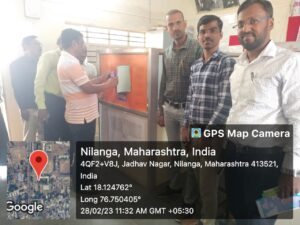 |
|
| 1 |
Local Historical Places Visit
|
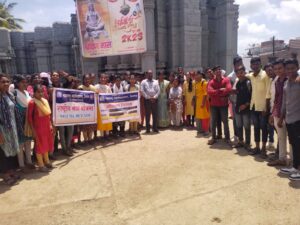 |
 |
||
| 2 |
Study tour |
 |
 |
||
| 3 |
National Seminar |
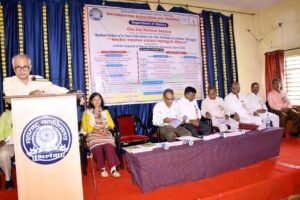
https://youtu.be/BAyjkYC8uZM?si=mgXMO2ZCeV9_sr7X |
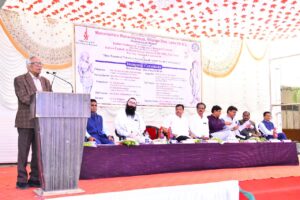 |
||
| https://youtu.be/Sd5fVLPvYA8?si=ySDO-8mE3wN55cDU
https://youtu.be/PHoV0OpFN0M?si=gxE-kqohjJqeGp8e https://youtu.be/CdU_brvhr18?si=DLNqgKbG_1jwGVkR https://youtu.be/BAyjkYC8uZM?si=mgXMO2ZCeV9_sr7X Brif Report National Conference Conference Photos News Paper Clipping National Conference |
- Notable Alumni
| Sr. No. | Academic Year | Name of the Alumni | Present Designation |
| 1. | 2015-16 | Pawar Dattatray Vilas | SET qualified, Assistant Prof. M.M. Nilanga |
| 2. | 2018-19 | Birajdar Harishchandra Ramesh | Indian Army |
| 3. | 2019-20 | Somwanshi Shradha Tukaram | Preparation UPSC |
| 4. | 2020-21 | Late Mayuri Mallikarjun | Gandhi Fellowship, Piramal Foundation |
| 5. | 2020-21 | Ghayal Vrandavan Sanjay | Maharashtra Police, Mumbai |
| 6. | 2021-22 | Panchal Sapna Dilip | Member, BOS History, SRTMU Nanded |
